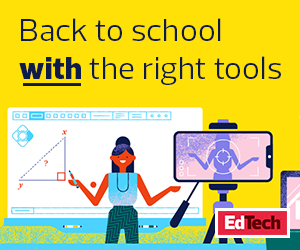When K–12 leaders implement expanded remote learning — whether at the start of the school year or as needed throughout the semester — teacher training will be crucial. The quick-fix tech training many schools offered in the spring will not provide the quality online teaching students need.
The scramble to implement remote learning in March left many educators with no option but to learn, apply and teach with unfamiliar virtual tools. Now, educators must be able to navigate remote learning and be skilled in technology tools. It also became evident that tech training would only get educators so far; to succeed at engaging, enhancing and extending student learning, teachers also need high-quality professional development that includes educational technology tools, as defined in the Triple E Framework.
Concerns about academic backsliding — the “COVID-19 slide” — adds to the urgency. School closings spurred by the coronavirus pandemic exacerbated educational disparities and may contribute to low student performance and skills mastery in the upcoming school year.
Continuing the ineffective model of remote learning implemented in the spring will make those problems worse. Educators had minimal experience with expanded, full-time online instruction; were given insufficient face-to-face training; and offered too few resources. Without high-quality training, they will continue to replicate instructional approaches they used in their brick-and-mortar classrooms before the pandemic. Teachers have the most significant impact on student learning, but without ongoing support and training, individual educators cannot take full ownership of technology-enhanced education.
Why Training Is Key to Improving Remote Learning Experiences
Educational technology leaders and other K–12 administrators are now under pressure to overcome the challenges of providing personalized professional development in a virtual environment and building educators’ capacity to develop e-learning skills. The model of professional development that is top-down, canned and heavy on presentation slides was proved ineffective and unsustainable even before school closures.
Districts can no longer afford to provide less-than-seamless training and learning opportunities for their educators, who are demanding effective, sustainable, high-quality, easily transferable and relevant learning opportunities. Best practices for teaching should drive technology use in the classroom by focusing on skills that can quickly transfer to an online or remote environment. District- and school-level back-to-school taskforces should include classroom teachers to identify expectations of technology use, revise curriculum development that incorporates technology and identify best practices when using technology as an instructional tool.
District and school leaders should ensure that processes are in place during professional development opportunities to support the diverse learning styles of teachers. By providing a variety of learning options, districts can guarantee their teachers will have support and access to training, ownership of their learning and the ability to assess their technical skill levels. It is also critical to scaffold learning, and one of the most effective tools for this is the Massachusetts Technology Self-Assessment Tool. Using this, educators can determine their level of tech proficiency and identify personal PD needs. The data collected assists schools and districts in assessing PD programs and planning activities that will help all teachers become proficient in technology. Using the ISTE Standards for Educators, personalized, structured and beneficial professional development opportunities can ensure that educators excel as learners, leaders, citizens, collaborators, designers, facilitators and analysts.
DISCOVER: Find four tips for effective virtual professional development.
Boost Learning in Physical and Virtual Classrooms with Consistency
Good teaching is good teaching, and school communities need to learn, share and collaborate on the outstanding education that is already happening. Educators who were skilled in pedagogy before school closures easily transferred effective teaching to the fully remote environment. Administrators would be wise to tap those rock-star educators to help assess, plan and lead effective professional development.
It’s also critical that administrators model the same powerful tools they expect educators to use to deliver instruction, assess students, provide interventions and support cultural diversity and different learning styles. Whatever the model used for professional development within a district, training teachers how to implement remote learning is a significant task. There are products available that provide comprehensive professional development support focusing on pedagogy using technology. Teq’s Otis for Educators offers free, high-quality online professional development courses for educators and school leaders to help them implement distance learning. EdTech Teacher’s T21 courses offer full-year, online professional development focused on teaching with technology in the 21st century.
What needs to be at the forefront of any development and implementation of remote learning professional development is the commitment of the entire school community to provide high-quality, personalized and engaging content and instruction. No matter whether teaching is in person or remote, schools need consistent and clear instructional practices and expectations that can be supported to ensure highly effective teaching and learning. School and district administrators must develop a school culture that embodies a shared sense of purpose, commitment and responsibility for giving students the best education possible.
LEARN MORE: Here's how school leaders can support educators teaching from home.














